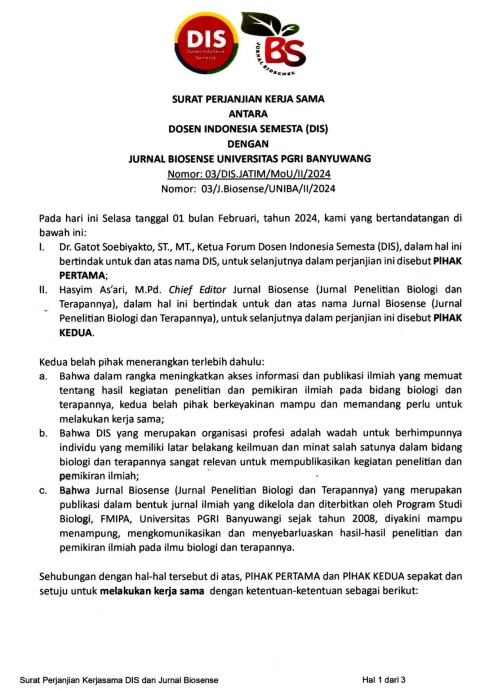FUNGSI REPRODUKSI DAN GAMBARAN HISTOLOGI ORGAN REPRODUKSI MENCIT (Mus musculus) BETINA PASCA PEMBERIAN KOPI
DOI:
https://doi.org/10.36526/biosense.v5i2.2057Keywords:
kopi, fungsi reproduksi, dan gambaran histologiAbstract
Penelitian ini bertujuan untuk mengetahui fungsi reproduksi dan gambaran histologi organ reproduksi mencit (Mus musculus) betina pasca pemberian kopi secara oral. Parameter yang diamati adalah berat badan, berat uterus, panjang siklus estrus, daya fertilisasi, jumlah folikel primer, jumlah folikel sekunder, diameter pembuluh darah ovarium, tinggi epitel endometrium, dan ketebalan endometrium dengan lama pemberian selama 21 hari dan 42 hari untuk parameter daya fertilisasi. Dosis kopi yang digunakan dalam penelitian ini adalah setara dengan tiga cangkir kopi pada manusia yang dikonversikan menjadi 0,5 ml pada mencit dan dilakukan empat kali pengulangan. Data yang diperoleh dianalisis dengan menggunakan uji t. Hasil penelitian menunjukkan pemberian kopi memberi pengaruh yang nyata terhadap jumlah folikel sekunder ovarium mencit dan tinggi epitel endometrium mencit, serta tidak berpengaruh nyata terhadap berat badan, berat uterus, panjang siklus estrus, daya fertilisasi, diameter corpus luteum, jumlah folikel primer, diameter pembuluh darah ovarium, ketebalan endometrium, dan ketebalan miometrium.
References
Ananda, Kaiin, E. M., Karja, N. W. K., & Setiadi, M. A. (2019). Perkembangan Sel Endometrium Domba setelah Inkubasi dalam Kolagenase dan Dikultur In Vitro dengan Estradiol dan Progesteron. Jurnal Veteriner, 20(3), 298. https://doi.org/10.19087/jveteriner.2019.20.3.298
Bode, A. M., & Dong, Z. (2007). The enigmatic effects of caffeine in cell cycle and cancer. Cancer Letters, 247(1–2), 26–39. https://doi.org/10.1016/j.canlet.2006.03.032
Cappelletti, S., Daria, P., Sani, G., & Aromatario, M. (2015). Caffeine: Cognitive and Physical Performance Enhancer or Psychoactive Drug? Current Neuropharmacology, 13(1), 71–88. https://doi.org/10.2174/1570159x13666141210215655
Cnattingius, S., Signorello, L. B., Annerén, G., Clausson, B., Ekbom, A., Ljunger, E., Blot, W. J., McLaughlin, J. K., Petersson, G., Rane, A., & Granath, F. (2000). Caffeine Intake and the Risk of First-Trimester Spontaneous Abortion. Obstetric and Gynecologic Survey, 343(25), 259–260. https://doi.org/10.1097/00006254-200105000-00006
Dixon, R. E., Hwang, S. J., Britton, F. C., Sanders, K. M., & Ward, S. M. (2011). Inhibitory effect of caffeine on pacemaker activity in the oviduct is mediated by cAMP-regulated conductances. British Journal of Pharmacology, 163(4), 745–754. https://doi.org/10.1111/j.1476-5381.2011.01266.x
Dorostghoal, M., Mahabadi, M. K., & Adham, S. (2011). Effects of maternal caffeine consumption on ovarian follicle development in Wistar rats offspring. Journal of Reproduction and Infertility, 12(1), 15–22.
Echeverri, D., Montes, F. R., Cabrera, M., Galán, A., & Prieto, A. (2010). Caffeine’s vascular mechanisms of action. International Journal of Vascular Medicine, 2010. https://doi.org/10.1155/2010/834060
Ehichioya, D. E., Oyesola, T. O., Ogbonna, R. C., Oyesola, O. A., & Ajiboye, K. I. (2016). Habitualcaffeine Consumption and Its Influence on Myocardial Fibers, Blood Pressure and Oxidative Status in Pregnant Albino Wistar Rats. International Journal of Advanced Research, 4(10), 1845–1854. https://doi.org/10.21474/ijar01/1994
European Coffee Federation. (2019). European Coffee Report 2018/2019. European Coffee Federation. https://www.ecf-coffee.org/wp-content/uploads/2020/09/European-Coffee-Report-2018-2019.pdf
Garriguet, D. (2009). Beverage consumption of Canadian adults. Statistics Canada, 19(4), 1–53. http://www5.statcan.gc.ca/access_acces/archive.action?loc=/pub/82-003-s/2005000/pdf/9087-eng.pdf&archive=1
Goldman, J. M., Murr, A. S., & Cooper, R. L. (2007). The rodent estrous cycle: Characterization of vaginal cytology and its utility in toxicological studies. Birth Defects Research (Part B), 80, 84–97. https://doi.org/10.1002/bdrb.20106
Gunawan, Setiatin, E. T., Rosadi, B., Hine, T. M., & Parakkasi, A. (2007). Performansi Reproduksi Tikus Betina dengan Pemberian Lendir Lidah Buaya. Jurnal Kedokteran Hewan, 1(1), 1–6. https://doi.org/10.21157/j.ked.hewan.v1i1.3101
Heffner, L. J., & Schust, D. J. (2008). The Reproductive System at a Glance (Second Ed.). Erlangga.
Kuper, H., Titus-Ernstoff, L., Harlow, B. L., & Cramer, D. W. (2000). Population based study of coffee, alcohol and tobacco use and risk of ovarian cancer. International Journal of Cancer, 88, 313–318. https://doi.org/10.1002/1097-0215(20001015)88:2<313::AID-IJC26>3.0.CO;2-5
Lelyana, R. (2008). Pengaruh Kopi Terhadap Kadar Asam Urat Darah Studi Eksperimen Pada Tikus Rattus Norwegicus Galur Wistar [Universitas Diponegoro]. In Universitas Di Ponegoro. http://eprints.undip.ac.id/19270/1/Rosa_Lelyana.pdf
Naderali, E. K., & Poyser, N. L. (1994). The effect of caffeine on prostaglandin output from the guinea‐pig uterus. British Journal of Pharmacology, 113(1), 103–110. https://doi.org/10.1111/j.1476-5381.1994.tb16180.x
National Coffee Association. (2022). Coffee consumption hits two-decade high - Spring 2022 National Coffee Data Trends report. National Coffee Association. https://www.ncausa.org/Newsroom/Coffee-consumption-hits-two-decade-high-2022-NCDT
Ping, J., Lei, Y. Y., Liu, L., Wang, T. T., Feng, Y. H., & Wang, H. (2012). Inheritable stimulatory effects of caffeine on steroidogenic acute regulatory protein expression and cortisol production in human adrenocortical cells. Chemico-Biological Interactions, 195(1), 68–75. https://doi.org/10.1016/j.cbi.2011.11.001
Qian, J., Chen, Q., Ward, S. M., Duan, E., & Zhang, Y. (2020). Impacts of Caffeine during Pregnancy. Trends in Endocrinology and Metabolism, 31(3), 218–227. https://doi.org/10.1016/j.tem.2019.11.004
Sari, R. M. (2011). Pengaruh Pemberian Ekstrak dan Fraksi daun Katuk (Sauropus androgynus (L.) Merr) Terhadap Proses Involusi Uterus Tikus Putih (Rattus norvegicus). Institut Pertanian Bogor.
Schliep, K. C., Schisterman, E. F., Mumford, S. L., Pollack, A. Z., Zhang, C., Ye, A., Stanford, J. B., Hammoud, A. O., Porucznik, C. A., & Wactawski-Wende, J. (2012). Caffeinated beverage intake and reproductive hormones among premenopausal women in the BioCycle Study. American Journal of Clinical Nutrition, 95, 488–497. https://doi.org/10.3945/ajcn.111.021287
Senger, P. (2005). Pathways to Pregnancy and Parturition. In Curent Conception, Inc. (Second Rev). Washington State University Research & Technology Park.
Supriati, R., Karyadi, B., & Maherawati. (2010). Pengaruh Pemberian Getah Buah Pepaya (Carica papaya L.) Terhadap Daya Fertilitas Mencit (Mus musculus) BALB/C Betina. Konservasi Hayati, 6(2), 1–8.
Tabrizi, R., Saneei, P., Lankarani, K. B., Akbari, M., Kolahdooz, F., Esmaillzadeh, A., Nadi-Ravandi, S., Mazoochi, M., & Asemi, Z. (2019). The effects of caffeine intake on weight loss: a systematic review and dos-response meta-analysis of randomized controlled trials. Critical Reviews in Food Science and Nutrition, 59(16), 2688–2696. https://doi.org/10.1080/10408398.2018.1507996
Utami, E. T., Fitrianti, R., Mahriani, & Fajariyah, S. (2009). Efek Kondisi Hiperglikemik terhadap Struktur Ovarium dan Siklus Estrus Mencit ( Mus musculus L). Jurnal Ilmu Dasar, 10(2), 219–224.

















